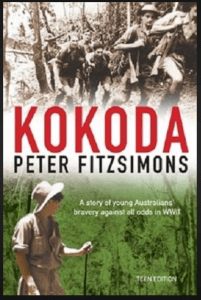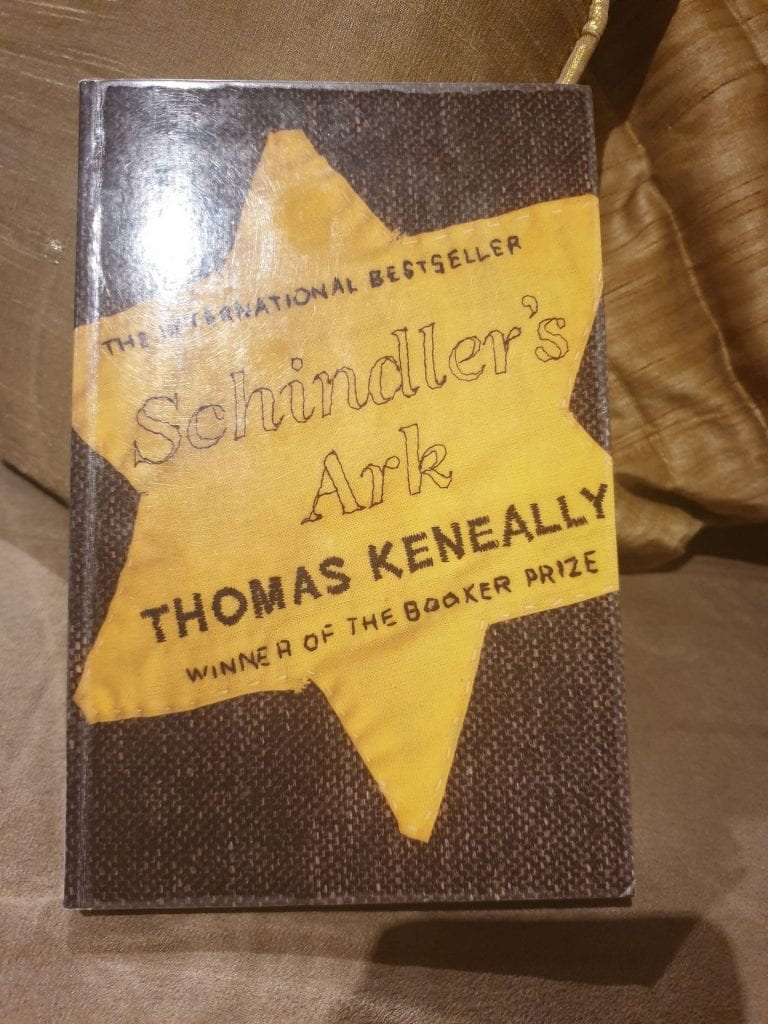Category Archives: book review
Book Bento Boxes – A fun reader response strategy.
Book Bento Boxes.
The name intrigued me immediately. I began to imagine miniature books presented artistically in a bamboo box. Then I remembered how un-artistic I am and the most creative experience I have had lately is using blue eyeliner instead of the stock standard black. Then I began to get hungry.
But I digress. Here is a Book Bento Box I prepared earlier using physical items.
Cover reproduced with permission from Kokoda: Teen edition by Peter FitzSimons, Hachette Australia, 2016.
Book bento boxes (BBB) is a multimodal and interactive reader response strategy to literature that promotes visual literacy, critical thinking and multiliteracy (Bales & Saint-John, 2020; Anstey & Bull, 2005). According to Bales (2018), BBB are adaptable and can be used at the beginning of a novel study to predict the events, in the middle to explain critical features or themes, or at the end of a unit of work to show understanding and comprehension. Most commonly used within the English curriculum, BBB can be successfully adapted to use across other disciplines for teaching and inquiry learning (Bales & Saint-John, 2020).
The concept underpinning book bento boxes is straightforward. Common household items or images are artistically arranged and used as points of reference for significant themes or events within the text (Bales & Saint-John, 2020). Their simplicity and scope for differentiation makes BBB an excellent strategy for capturing understanding in a formal or informal setting (Bales, 2018).
Far different from traditional book reports, BBB provides an alternative and creative method for promoting discourse (Anstey & Bull, 2006, p. 22). It allows the student to engage with the text and respond in a manner that utilises their own knowledge bank and best suits their abilities, as each reader’s comprehension of the text will differ to their peers due to the disparity in views, perspectives and mental acuity (Derewianka, 2015).
We have acknowledged that discourse is important for improving student understanding and success and the traditional method for discourse has been literature circles and book reports. I have previously discussed this in other blog posts, for example The books we read aloud are the ones that resonate the most so I will leave it here. BBB are an ideal reader response strategy for high school classrooms as they can be easily differentiated for diverse learners and promote multimodal literacy.
Here is a Book Bento Box I prepared using digital images (all with CC 4.0 or 2.0).
BBB can range from simple posters, to interactive digital images with embedded links for videos and external websites (Bales, 2018). They can be created individually or in collaborative learning groups, for teaching and learning as well as for assessment purposes.
Remember the poster presentation from days before Powerpoint? In the world before Powerpoint and mobile devices, students would create posters using cardboard, paper, coloured pens and magazine collages. This BBB option is still available for young children, or older students with minimal access to devices and software. In most Australian secondary schools, many students have access to mobile devices such as laptops or smartphones, so they are able to create digital images with or without embedded interactive features. By including annotations or a rationale with their work, the reader is able to justify the inclusion of their supporting items and thus illustrate their knowledge and understanding of the text (Bales & Saint-John, 2020).
The process to create a book bento box is quite simple and more detail instructions are here:
- Select a text.
- Select items or images that correspond to themes or events in the text.
- Arrange the items as artistically as possible.
- Take a photo.
- Edit the photo either using Powerpoint or your camera filters.
- Upload the image to Thinglink or you can keep using Powerpoint or Prezi or a poster.
- Add the interactive features (if desired).
- Add annotations or rationale (if desired).
- Share to learning management systems and emails (if desired).
So why is there a need to implement BBB into teaching and learning? Why change things up?
To put it simply, the reading paradigm has changed and therefore pedagogy must also change to support students in this new world (Mangen, Walgermo & Bronnick, 2013). As mentioned earlier, there are sufficient pedagogical reasons to use book bento boxes in teaching and learning. Firstly, exposure to a variety of good quality texts embedded across the curriculum has been proven to extend ICT capabilities, intensify engagement, improve cognition, boost emotional development and increase recall. By using this reader response strategy, students are increasing their visual literacy, critical thinking and consequently multiliteracy capabilities. It is also a whole lot of fun!!
References:
Anstey, M., & Bull, G. (2006). Teaching and learning multiliteracies: Changing times, changing literacies . Newark, Del.: International Reading Association.
Bales, J. (2018, September 23). Book Bento Boxes. [Blog]. Retrieved from https://jenniebales.wordpress.com/2018/09/24/book-bento-boxes/
Bales, J., & Saint-John, L. (2020) Book Bento Boxes: Creative reading response. SCAN, 39. Retrieved from https://education.nsw.gov.au/teaching-and-learning/professional-learning/scan/past-issues/vol-39-2020/book-bento-boxes–creative-reading-response
Derewianka, B. (2015). The contribution of genre theory to literacy education in Australia. In J. Turbill, G. Barton & C. Brock (Eds.), Teaching Writing in Today’s Classrooms: Looking back to looking forward (pp. 69-86). Norwood, Australia: Australian Literary Educators’ Association. Retrieved from https://ro.uow.edu.au/cgi/viewcontent.cgi?article=2620&context=sspapers
Mangen, A., Walgermo, B. R. & Bronnick, K.A. (2013). Reading linear texts on paper versus computer screen: Effects on reading comprehension. International Journal of Educational Research, 58, 61-68.doi:10.1016/j.ijer.2012.12.002
Book Review – Olivia Twist by Strauss, Dalva, Vieceli and Loughridge.
Title:
Authors and Illustrators:
Darin Strauss, Adam Dalva, Emma Vieveli and Lee Loughridge.
Published by:
Dark Horse Publishers (2019).
Olivia Twist is a dystopian graphic novel parody of the Dickens classic ‘Oliver Twist” that is set in futuristic 2050 London, where society is racially divided and the politically strong have a dependence on artificial intelligence. This particular edition is a compilation of four consecutive stories. Fans of the Dickens narrative would be able to easily identify the several similarities between the traditional version and this text, including the inclusion of characters such as Mr Beedle, Fagin, Artful Dodger and the presence of violent street gangs.
This GN Olivia Twist is a very complex text. The illustrations are brilliant, and much of the storyline is coded within the visual elements. The use of colour, line and framing causes the reader to become immersed in the storyline. As the plot contains several twists and turns, the reader is forced to question the direction of the narrative and make predictions as to the actions of the protagonist. The text contains several attributes that appeal to teenagers. Obviously the predominating feature is that this is a graphic novel. Graphic novels are very popular with children and teenagers, and their multimodality promotes the development of 21st century skills such as visual literacy, critical thinking and intertextuality (Botzakis, 2018). Furthermore, this dystopian text breaks gender stereotypes, contains elements of Bildungsroman, and promotes moral development.
As a fan of the original version, I found it difficult to read this text without comparing it to the original novel. Additionally, my visual literacy is still emerging so decoding the images and illustrations required more time and effort than I expected. I had to read this GN a few times to understand it properly and to see all of its different layers. This book would be suitable for students over the age of 14 due to the presence of swearing and frequent depictions of violence. This GN meets English curriculum links in years 9 and 10 and would make an excellent substitute or alternative novel study to Huxley’s Brave New World, Dashner’s Maze Runner and Collins’ Hunger Games.
Graphic novels (GN) are an excellent addition to school library collections. When used in educational practices, GN fosters comprehension and increases recall. As the text is supported by images, GN are ideally suited to students with developing literacy (Botzakis, 2018). Their visual permanence means that the reader can choose their own reading pace and allows them to re-read as needed. But just reading GN does not mean that the students’ literacy levels will instinctively improve. GN requires the reader to make inferences, which promotes high order thinking, as well as providing contextual information to the reader (Botzakis, 2018). Their complex nature means that educators need to teach decoding and comprehending GN the same way as they teach traditional texts (Botzakis, 2018).
Good GN possess traditional narrative features such as an overarching theme, depth of plot, character development and use of literary devices (Gonzales, 2016). Additionally, they also have classic film elements such as line, colour, focus, transitioning and framing (Gonzales, 2016). One of the discerning factors between a literary GN and a comic strip is the depiction of women (Gonzales, 2016). Unlike vintage comics where the female characters resemble wasp shaped Amazons that may or may not have floss for brains, modern GN acknowledge that young girls need strong and clever female protagonists. Olivia Twist’s twist on the Dicken’s classic has strong female characters. An example of this strength would be the character of Fagin and her female band of misfits, code named Esthers, all of whom are fiesty women that exhibit racial and physical diversity.
Brannen (2013) believes that teenagers like to read about characters that have personal struggles that relate to ‘coming of age’. In this text, Olivia has lived her whole childhood starved of love and a family. She seems unaware of her own inner strength and manages to overcome all her obstacles with determination and innate need to protect those weaker than herself. After all, isn’t morality and ethics about ensuring all members of society are dealt with fairly? Not just the loudest and strongest, but even the small, weak and innocent.
Whilst Olivia Twist cannot be described as a contemporary realistic fiction due to its dystopian and science fiction characteristics, there are elements of Bildungsroman present within the text. Bildungsroman is a term used to describe texts that are centralised upon the development of a youthful protagonist (Cody, 2005). This development is usually focused on socio-cultural themes such as morality, race and class, as it provokes vigorous social discourse.
The inclusion of these themes and following social discourse allows the adolescent reader to develop their moral compass (Bushman & McNerny, 2004). Olivia’s love for Pip and her determination to keep him safe ends up being the deciding factor in her survival. Moral development in teenagers is shaped by the moral dilemmas they are exposed to. Reading fictitious stories that have moral choices within help students to differentiate between what is right and what is wrong. After all, as Edmund Burke famously said “The only thing necessary for the triumph of evil is for good men to do nothing” (quotationspage.com). When considering this text’s similarity to the previously mentioned texts by Huxley, Dashner and Collins, the similar vein in all three, is an ethical dilemma faced by the fringes of society.
The actions by the protagonist in all of these texts could be viewed as legally wrong by the prevailing standards of their society. The reader is able to engage with these moral and ethical dilemmas and with the help of social discourse, determine if the actions of the character were truly wrong or is the society actually at fault? Society is not an indicator of social morality. History has proven time and time again that what is right and what society determines is right can be two very different things. Just look at the evolution of civil rights. In the 1800’s, women were considered property and did not have the right to own property in their own right or vote. Whilst this has been overturned in most nations, some cultures still inhibit women from equal participation. In Australia, the Indigenous peoples were considered as part of the ‘flora and fauna’ till a national referendum in 1967 revoked that viewpoint and Indigenous people were then included as part of the national census. As individuals, we all play a part in monitoring the morality of society.
Classic young adult novels such as Olivia Twist lure the reader into the storyline with its multimodal format and then provokes them into analysing the character and their actions. The reader is able to evaluate the actions of the protagonist and decide if the action is acceptable or not. It is through this evaluation process that the reader develops their moral compass. Besides addressing curriculum links within the English curriculum, the strong female protagonist in the narrative provides a positive depiction of women and this is really important for young girls. The inclusion of good graphic novels into high school library collections meets the cognitive, behavioural and developmental needs of young adult readers.
References:
Botzakis, S. (2018). Comics in the classroom: Using graphic novels for content learning. In D. Wooten, B. Cullinan, L. Liang & R. Allington (Eds). Children’s literature in the reading program: Engaging young readers in the 21st century, (5th ed., pp. 140-152). Retrieved from Proquest Ebook Central.
Brannen, J. (2013). All about realistic fiction for teens. NoveList. Retrieved from https://www.ebscohost.com/uploads/novelist/pdf/Teen_RealisticFiction_GenreOutline.pdf
Bushman, J.H. & McNerny, S. (2004). Moral choices: Building a bridge between YA literature and life. ALAN Review, 32(1), 61-67. Retrieved August 2016.
Cody, D. (2005). Bildungsroman. Victorian Web – Literature, History & Culture in the age of Victoria. Retrieved from http://www.victorianweb.org/genre/bildung.html
The Quotations Page. (2018). Edmund Burke. Retrieved from http://www.quotationspage.com/quotes/Edmund_Burke/
Gonzalez, J. (2016). Graphic novels in the classroom. [Blog] Cult of Pedagogy. Retrieved from https://www.cultofpedagogy.com/teaching-graphic-novels/
Book Review – A bad boy stole my bra by Lauren Price
Title: A Bad Boy stole my Bra
Author: Lauren Price
Published: Ink Road, 2018.
Verdict: I AM TOO OLD FOR THIS BOOK!
Ok I am probably being melodramatic here! Price’s book is funny and quirky and everything a tween or younger teen would like.
Reasons being:
- The title catches the eye.
- The language is witty and funny.
- The storyline is very popular with teenage girls.
- It is a classic YA novel.
I, on the other hand, am about a score of years too old for a book like this!!
Reasons being:
- The vision of waking up to a random male holding up my wired underwear is rather frightening.
- After being in a stable relationship for nearly fifteen years, the idea of dating is also frightening.
- And the only one I want holding my bra up is the person who is hanging up my washing!
I am too old to be reading books like this.
THE END.
Book Review – Kokoda by Peter Fitzsimons
THE BOOK: Kokoda (Teen Edition) by Peter Fitzsimons.
Published by Hachette Australia in 2016
Cover reproduced with permission from Kokoda: Teen edition by Peter FitzSimons, Hachette Australia, 2016.
The Summary: Kokoda is a well written narrative non fiction book by an acclaimed Australian writer Peter Fitzsimons. The story is about a group of young Australian men, most still teenagers, trying to make a stand against the much stronger Imperial Japanese Army in the treacherous terrain of Papua New Guinea. The story of the Kokoda trail is eerily similar to Gallipoli, and for many people this historical event builds upon the ANZAC legend. Aimed at readers over 12 years old, this book is ideal for teenagers to read for recreational and academic purposes.
The Good: Fitzsimons captures the essence of the young Australian men magnificently. His use of colloquial language and casual references to Sydney strests gives the reader confidence in the author’s authenticity and veracity. Kokoda is a well written text that describes the events of 1942 in superb detail. Battle scenes and forced marches are brought to life vividly. His use of language was subtle, allowing the reader to become engaged with the story but at the same time not overwhelming them with military jargon and complex sentences. This book’s storyline and prosaic style would suit teenage boys very well.
The Bad: The format of the book was consistent with other expository texts with the inclusion of a contents page, maps, photographs, reference list and index. But unlike many other information texts, this book did not have any other additional resources, such as links to further reading or websites such as the Australian War Memorial Kokoda Collection.
The Interesting: It was interesting reading Fitzsimons’ perspective on the Kokoda campaign as his stance differs from the viewpoints of other war writers and journalists. Unlike the official war reports, Fitzsimons is quite scathing of the military hierarchy’s competency. He is very blunt in the way he points out that Australians died in New Guinea because of mismanagement. He also points out the conflict between the celebrated MacArthur’s battle plan and Pott’s frontline perspective. Fitzsimons is just short of scathing in the way he refers to MacArthurs’s speaking of battle tactics whilst safely ensconced in his office over 2000 km away from the jungles of New Guinea. He also discusses the Battle of Milne and points out the manner in which MacArthur claimed the victory as part of his plan rather than the effort of Australian boots on the ground.
The Verdict: Kokoda meets content standards within the Year 10 History Curriculum – Experiences of Australians during World War 2. It is an excellent resource for teenagers as it contains both facts and figures, yet written in a narrative style. This style allows the reader to become engaged with the text and have an increased recall of the information within. Intermixing prose and factual information requires the reader to become more analytical and thus improves critical thinking skills. The conflicting views that Fitzsimons offers about MacArther gives the reader a chance to question bias in texts. The book also allows the reader to connect their prior knowledge of the Gallipolli digger to the story of the Kokoda trekker and build their knowledge of Australian history. Additionally, as the book is classified as a non fiction resource, more classroom teachers are comfortable using them as resources for teaching and learning. This is because some educators have an unconscious bias towards the implementation of literature outside the language arts curriculum. Kokoda would be an asset for high school library collections and a useful literacy resource.
Book Review – Wilder Girls by Rory Power
The blurb says it all…
“First the teachers died, one by one. Then it began to infect the students, turning their bodies strange… left to fend for themselves on their island home, the girls don’t dare wander outside the school’s fence… they wait for the cure they were promised”.

jewhisperer / Pixabay – The enemy is invisible
Wilder Girls (2019) by Rory Power is a dystopian novel set in a boarding school on an island off the American seaboard. A strange, body transforming disease that infects all living life, lurks in the forest surrounding the school and has started to infect everything on the island. The authorities, worried about this disease leaking out, have shut down all access to the island leaving the girls to fend for themselves. With an eerie similarity to Golding’s Lord of the Flies, Wilder Girls highlights humanity’s anthropological need to set up a social hierarchy in the absence of an established system. But unlike Golding’s work, Power showcases the strength of human connectedness between the protagonist Hetty and her best friend Byatt. It is this robustness of this connection that spurs Hetty to search for her friend in the disease ridden woods.

sweetlouise / Pixabay – Being connected
Dystopian novels have always been traditionally favoured with teenagers. Marsden’s Tomorrow when the war began, Grant’s Gone, Roth’s Divergent, Dashner’s Maze Runner and Collin’s Hunger Games are just some examples of this genre and are all popular titles. Dystopian fiction has traditionally been based around conflict between an individual and society and often has fantastical elements. Their appeal to teens is based upon their ability to address inner angst in teenagers and rebellious ideologies (Basu, Broad & Hintz, 2013). Additionally, this genre allows the reader to make moral observations about society in general. In Power’s Wilder Girls, Hetty and Byatt have a physical altercation over an orange even though they are best friends. In their mind, it’s perfectly acceptable to resort to violence to obtain food, whereas to my mind, it seems abhorrent and distasteful. But I am not hungry, and in many parts of the world, people DO fight for food. In this way, Power points to the quick demise of social trappings of sophisticated society in times of survival and that actions and circumstances need to be evaluated together rather than in isolation. Remember, people were fighting over toilet paper in February and March 2020.

Alexas_Fotos / Pixabay – Toilet paper gate of 2020
Wilder Girls was outside my comfort zone as I originally picked it up as a bit of a lark due to the current COVID-19 pandemic. But whilst the book’s storyline itself was not to my liking ( pandemic and all, yes, I agree, completely wrong time to read this book!), I loved the way Power showcased the friendship between Hetty and Byatt. The sheer connection between these two girls gave Hetty the will to strike out into the unknown to look for her best friend amazed me and brought cheer to my spirit. It reminded me of the movie, Forrest Gump when Forrest went to look for Bubba in the jungles of Vietnam. I won’t tell you the ending of Wilder Girls but I will say that friendship matters.

truthseeker08 / Pixabay – Staying in touch
Peer relationships are important for teenagers, and for people of all ages. It is our relationships, and conflict within these associations with our friends and family that set up our social and emotional frameworks. Reading fiction covertly teaches the reader about emotional regulation that accompanies conflict. This regulation is essential for social development and human interactions and the ability to regulate such emotions is known as emotional literacy (Laurie, 2016). The reading of Wilder girls did not bolster my belief in #scottyfrommarketing to resolve the current COVID pandemic, but rather instead made me reach for my phone to text my girlfriends and say “Hey, I miss you”.
Basu, B. Broad, K.R., & Hintz, C. (2013). Contemporary dystopian fiction for young adults: Brave new teenagers. Oxfordshire, UK. Routledge. Retrieved from https://ebookcentral.proquest.com/lib/CSUAU/detail.action?docID=1186446
Laurie, H. (2016). Using picture books to promote social-emotional literacy. YC Young Children, Volume 71(3). pp80-86. Retrieved from https://www.naeyc.org/
Book Review – Schindler’s Ark by Thomas Keneally
Schindler’s Ark by Thomas Keneally was a very dry read. It was drier than the cheapest plonk at the pub during happy hour. Now before anyone starts collecting rocks to stone me, I would challenge them to read the book too and then comment.
I am not denying that the material in the book is powerful. I definitely acknowledge that the book is filled with names, places and intense facts. But it is not prose. Upon thinking this further, I recollect the subject of the book and wonder if there is a reason for that. If the author, in this case Thomas Keneally was aiming for an emotive piece, it would be a character lie. By all accounts, Oskar Schindler was a hard drinking and reckless businessman who cheated on his wife with regularity (Hurvitz & Karesh, 2016). He destroyed his family business, sought to cheat, lie and swindle his way back into a life of comfort. Quite frankly, by all tokens, this man was an immoral and wasteful character. Then Schindler went on to save almost 1300 Jews from the concentration camps during those dark days in Eastern Europe. This man, who by the standards of his time, and now; unworthy of attention; put his own life at risk to save others. His actions have been immortalised in a book, a major Spielberg movie production and the term Schindlerjuden or Schindler’s Jews, which is still used to refer to the descendents of those that were saved.
So when you consider all these facts, the dryness of Keneally’s “Schindler’s Ark” makes sense. It would be a lie if the book was anything other than prosaic. Instead, its matter of fact manner of describing the main character’s traits ensures that the reader does not view him with rose framed lenses. The reader is made fully aware of Oskar’s failings as a man and a husband. It is in viewing these failings that Schindler’s true heroism is seen. The plain language allows the reader to envision the fear hiding between the stalwart words. Conversely, the plain language also allows readers with little imagination to read the book without being overwhelmed.
“Schindler’s Ark” was a very dry read for someone who is a lover of prose. As an avid reader of fiction, I found this novel to be more informative than anything else. I also found it heartbreaking, just like the sadness I feel when the happy hour wine is just awful. But whilst this book was a struggle for me, it would be ideal for reluctant teens who struggle with engaging with fictitious stories. The language, style and format of the book resemble information books and thus may satisfy their need for ‘facts’. But whilst the Guardian review suggests this book as appropriate for 8-12 year old children, I would probably restrict it to students over 14-15 years old. This would then correlate well with the year 10 HASS’s World War 2 and Holocaust unit especially the ACDSEH025 elaboration. It would also work well in the Biographies and memoirs unit in Year 10 English.
REFERENCES:
Alannahbee, (2013). Schindler’s Ark by Thomas Keneally – review. The Guardian. Retrieved 16th March, 2020 from https://www.theguardian.com/childrens-books-site/2013/sep/25/review-schindler-s-ark-by-thomas-keneally
Axelrod, A. (2013). Schindler, Oskar. In Encyclopedia of World War II, vol. 2. New York: Facts On File. Retrieved March 16, 2020, from online.infobase.com/Auth/Index?aid=19165&itemid=WE53&articleId=265017.
Hurvitz, M. M., & Karesh, S. E. (2016). Schindler, Oskar. In Encyclopedia of Judaism, Second Edition. New York: Facts On File. Retrieved March 16, 2020, from online.infobase.com/Auth/Index?aid=19165&itemid=WE53&articleId=263928.


